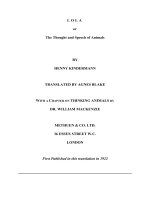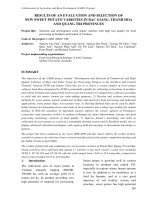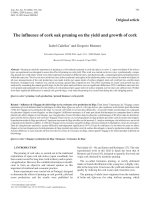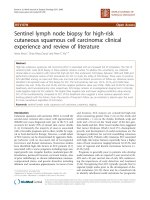CHARACTER AND VARIETIES OF MANURES NAND EXCREMENTS OF ANIMALS pps
Bạn đang xem bản rút gọn của tài liệu. Xem và tải ngay bản đầy đủ của tài liệu tại đây (156.07 KB, 9 trang )
CHARACTER AND VARIETIES OF MANURES
NAND EXCREMENTS OF ANIMALS
What must a farmer know in order to avoid failures?
Can this be learned entirely from observation?
What kind of action have manures?
Give examples of each of these.
May mechanical effects be produced by chemical action?
How does potash affect the soil?
To understand the science of manures is the most important branch of practical
farming. No baker would be called a good practical baker who kept his flour exposed
to the sun and rain. No shoemaker would be called a good practical shoemaker, who
used morocco for the soles of his shoes, and heavy leather for the uppers. No
carpenter would be called a good practical carpenter, who tried to build a house
without nails, or other fastenings. So with the farmer. He cannot be called a good
practical farmer if he keeps the materials, from which he is to make plants, in such a
condition, that they will have their value[Pg 94] destroyed, uses them in the wrong
places, or tries to put them together without having every thing present that is
necessary. Before he can avoid failures with certainty, he must know what manures
are composed of, how they are to be preserved, where they are needed, and what kinds
are required. True, he may from observation and experience, guess at results, but he
cannot know that he is right until he has learned the facts above named. In this section
of our work, we mean to convey some of the information necessary to this branch
of practical farming.
We shall adopt a classification of the subject somewhat different from that found in
most works on manures, but the facts are the same. The action of manures is
eithermechanical or chemical, or a combination of both. For instance: some kinds of
manure improve the mechanical character of the soil, such as those which loosen stiff
clay soils, or others which render light sandy soils compact—these are
calledmechanical manures. Some again furnish food for plants—these are
called chemicalmanures.
Many mechanical manures produce their effects by means of chemical action.
Thuspotash combines chemically with sand in the soil. In so doing, it[Pg 95] roughens
the surfaces of the particles of sand, and renders the soil less liable to be compacted by
rains. In this manner, it acts as a mechanical manure. The compound of sand and
potash,
[U]
as well as the potash alone, may enter into the composition of plants, and
hence it is a chemical manure. In other words, potash belongs to both classes
described above.
It is important that this distinction should be well understood by the learner, as the
words "mechanical" and "chemical" in connection with manures will be made use of
throughout the following pages.
What are absorbents?
What kind of manure is charcoal?
There is another class of manures which we shall call absorbents. These comprise
those substances which have the power of taking up fertilizing matters, and retaining
them for the use of plants. For instance, charcoal is an absorbent. As was stated in the
section on soils, this substance is a retainer of all fertilizing gases and many minerals.
Other matters made use of in agriculture have the same effect. These absorbents will
be spoken of more fully in their proper places.
TABLE.
MECHANICAL MANURES
are those which improve the mechanical condition of soils.
[Pg
96]CHEMICAL "
are those which serve as food for plants.
ABSORBENTS
are those substances which absorb and retain fertilizing
matters.
Into what classes may manures be divided?
What are organic manures?
Inorganic? Atmospheric?
Manures may be divided into three classes, viz.: organic, inorganic, andatmospheric.
ORGANIC manures comprise all animal and vegetable matters which are used to
fertilize the soil, such as dung, muck, etc.
INORGANIC manures are those which are of a purely mineral character, such as lime,
ashes, etc.
ATMOSPHERIC manures consist of those organic manures which are in the form of
gases in the atmosphere, and which are absorbed by rains and carried to the soil.
These are of immense importance. The ammonia and carbonic acid in the air are
atmospheric manures.
EXCREMENTS OF ANIMALS
Of what is animal excrement composed?
Explain the composition of the food of animals.
What does hay contain?
To what does Liebig compare the consumption of food by animals, and why?
The first organic manure which we shall examine, is animal excrement.
This is composed of those matters which have been eaten by the animal as food, and
have been thrown off as solid or liquid manure. In order that[Pg 97] we may know of
what they consist, we must refer to the composition of food and examine the process
of digestion.
The food of animals, we have seen to consist of both organic and inorganic matter.
The organic part may be divided into two classes, i. e., that portion which contains
nitrogen—such as gluten, albumen, etc., and that which does not contain nitrogen—
such as starch, sugar, oil, etc.
The inorganic part of food may also be divided into soluble matter
and insolublematter.
DIGESTION AND ITS PRODUCTS.
Of what does that part of dung consist which resembles soot?
What else does the dung contain?
In what manner does the digested part of food escape from the body?
Let us now suppose that we have a full-grown ox, which is not increasing in any of his
parts, but only consumes food to keep up his respiration, and to supply the natural
wastes of his body. To this ox we will feed a ton of hay which contains organic
matter, with and without nitrogen, and soluble and insoluble inorganic substances.
Now let us try to follow it through its changes in the animal, and observe its
destination. Liebig compares the consumption of food by animals to the imperfect
burning of wood in a stove, where a portion of the fuel is resolved into gases and
ashes (that is, it is completely burned), and[Pg 98] another portion, which is not
thoroughly burned, passes off as soot. In the animal action in question, the food
undergoes changes which are similar to this burning of wood. A part of the food
is digested and taken up by the blood, while another portion remains undigested, and
passes the bowels as solid dung—corresponding to soot. This part of the dung then,
we see is merely so much of the food as passes through the system without being
materially changed. Its nature is easily understood. It contains organic and inorganic
matter in nearly the same condition as they existed in the hay. They have been
rendered finer and softer, but their chemical character is not materially altered. The
dung also contains small quantities of nitrogenous matter, which leaked out, as it
were, from the stomach and intestines. The digested food, however, undergoes further
changes which affect its character, and it escapes from the body in three ways—i. e.,
through the lungs, through the bladder, and through the bowels. It will be recollected
from the first section of this book, p. 22, that the carbon in the blood of animals, unites
with the oxygen of the air drawn into the lungs, and is thrown off in the breath as
carbonic acid. The hydrogen and oxygen unite to form a part of the water which
constitutes the moisture of the breath.[Pg 99]
Explain the escape of carbon, hydrogen and oxygen.
What becomes of the nitrogenous parts?
How is the soluble ash of the digested food parted with?
The insoluble?
If any portions of the food are not returned in the dung, how are they disposed of?
That portion of the organic part of the hay which has been taken up by the blood of the
ox, and which does not contain nitrogen (corresponding to the first class of
proximates, as described in Sect. I), is emitted through the lungs. It consists, as will be
recollected, of carbon, hydrogen and oxygen, and these assume, in respiration, the
form of carbonic acid and water.
The organic matter of the digested hay, in the blood, which contains nitrogen
(corresponding to the second class of proximates, described in Sect. I), goes to
thebladder, where it assumes the form of urea—a constituent of urine or liquid
manure.
We have now disposed of the imperfectly digested food (dung), and of
the organicmatter which was taken up by the blood. All that remains to be examined
is the inorganic or mineral matter in the blood, which would have become ashes, if the
hay had been burned. The soluble part of this inorganic matter passes into the bladder,
and forms the inorganic part of urine. The insoluble part passes the bowels, in
connection with the dung.
How is their place supplied?
Is food put out of existence when it is fed to animals?
What does the solid dung contain? Liquid manure? The breath?
If any of the food taken up by the blood is not returned as above stated, it goes to form
fat, muscle, hair, bones, or some other part of the animal, and as[Pg 100] he is not
growing (not increasing in weight) an equivalent amount of the body of the animal
goes to the manure to take the place of the part retained.
[V]
We now have our subject in a form to be readily understood. We learn that when food
is given to animals it is not put out of existence, but is merely changed in form; and
that in the impurities of the breath, we have a large portion of those parts of the food
which plants obtain from air and from water; while the solid and liquid excrements
contain all that was taken by the plants from the soil and manures.
The SOLID DUNG contains the undigested parts of the food, the insoluble parts of the ash, and the
nitrogenous matters which have escaped from the digestive organs.
"LIQUID MANURE" the nitrogenous or second class of proximates of the [Pg 101]digested food, and
the soluble parts of the ash.
THE BREATH contains the first class of proximates, those which contain carbon, hydrogen and
oxygen, but no nitrogen.
[W]
FOOTNOTES:
[V]This account of digestion is not, perhaps, strictly accurate in a physiological point
of view, but it is sufficiently so to give an elementary understanding of the character
of excrements as manures.
[W]The excrements of animals contain more or less of sulphur, and sometimes small
quantities of phosphorus.









